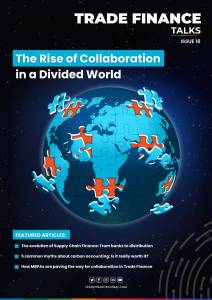Estimated reading time: 6 minutes
The trade finance industry offers a diverse range of instruments, structures, and mechanisms, all aimed at transforming trade opportunities into tangible realities. One such mechanism employed by financial institutions is the utilisation of Master Risk Participation Agreements (MRPAs).
These agreements enable active risk participation, allowing financial institutions to effectively manage and distribute risks, safeguarding the interests of all parties involved while promoting a resilient international trade ecosystem.
In this episode of Trade Finance Talks, Mark Abrams, Managing Director, Global Head of Trade & Receivables Finance at Trade Finance Global, spoke with Geoffrey Wynne, Partner and head of Sullivan’s Trade & Export Finance Group, to explore the evolution, significance, and future prospects of MRPAs.
Understanding the evolution and function of MRPAs
Risk Participation Agreements (RPAs) are a means of sharing risk in trade finance transactions, which originated primarily between banks. These agreements enable financial institutions to transfer a portion of their transactional risk to other parties while maintaining a customer-facing role.
As Wynne explained, “When a bank wanted to stay forward facing to the customer while it transferred part of the risk of that transaction to another party, participation agreements were a great way of doing it.”
In addition, Wynne highlighted the two main types of risk participation: funded and unfunded.
In funded risk participation, he noted, “Funded risk participation is where the seller of the risk is funded by the participant on day one and then pays the money back when it’s paid back.”
This type of participation ensures that the participant is directly involved in financing the transaction from the beginning. On the other hand, unfunded risk participation covers the risk without immediate funding.
The participant is obligated to pay only in the event of a default, earning a return for assuming the risk. This type of participation allows for risk transfer without the need for upfront funding.
Furthermore, the need for standardisation in risk participation agreements became apparent when various banks independently drafted their own set of agreements. The lack of consistency coupled with the complex nature of trade finance prompted a group of banks to take action and initiate a standardisation process.
This collaborative effort led to the introduction of MRPAs, including the widely recognised BAFT MRPAs, in 2008. The standardisation of MRPAs has established an industry-wide framework for banks and their counterparties in the global trade finance market. It simplified trade finance transactions, streamlined negotiations, and enhanced transparency.
To complement the BAFT MPRA, ITFA launched the Master Participation Agreement for Unfunded Participations in 2019 (drafted by Sullivan), mainly for insurance companies. More information on this, for the purposes of Article 194 of CRR, can be found here, where TFG spoke to ITFA’s Silja Calac.
The challenges and considerations when engaging in MRPAs
Dealing with MRPAs involves navigating challenges and considerations that require striking a balance between the interests of both the seller and participant while adhering to regulatory and compliance obligations.
Wynne emphasised this balance, stating, “We tried to balance the position between the seller of the participation and the participant. The seller says to the participant: here are all the documents, if you accept my offer, then you’re in the transaction.”
Evidently, companies should carefully review the provided documentation, assess their risk exposure, and align the terms of the MRPA with their objectives and risk appetite.
Alongside the need for balance, regulatory and compliance considerations come into play. The core objective is to ensure the effective transfer of risk from the seller to the participant.
Wynne pointed out, “From a regulatory and legal point of view, the idea is to make sure that the risk is transferred from the seller to the participant.” Sellers seek assurance that the risk is successfully transferred, whether through selling or funding, to remove it from their books.
Conversely, participants want to ascertain their rights to the underlying transaction and understand their obligations, particularly if they are funded. It is essential to align the MRPA with regulatory requirements, ensuring transparency, accountability, and clear delineation of rights and responsibilities for all involved parties.
Unlocking trade finance opportunities: The impact of MRPAs on the trade finance gap and driving inclusion
The standardisation of MRPAs plays a notable role in reducing the trade finance gap and promoting inclusion within the industry. MRPAs provide a standardised method of transferring risk, making it easier for participants to evaluate and join transactions.
As Wynne said, “You’ve got a standard way of transferring risk. Consequently, it makes life a lot easier.”
The use of BAFT-based MRPAs as an industry-standard framework has enhanced transparency and facilitated more efficient participation in trade finance transactions, “Since the transaction will be based on BAFT, the participant already has a pretty good idea of how it’s going to become involved in it,” Wynne added.
Besides facilitating risk transfer, MRPAs open doors for non-bank originators and investors to enter the trade finance market. By signing an MRPA, these entities gain direct rights and increased confidence in their participation.
Wynne underscored the simplicity of this approach, stating, “If you sign this MRPA, you are getting direct rights against the party paying. It is that simple.”
The inclusion of guarantees or credit insurance further mitigates credit risks and reinforces confidence among non-bank originators and investors.
Moreover, MRPAs demonstrate versatility in accommodating different market participants. While originally designed as a two-way document for sellers and participants, Wynne explained that the current usage often involves one-way agreements tailored to specific needs.
He noted, “A lot of the work we do now is one way, which is exactly right.” This adaptability allows for variations in structures and arrangements, offering flexibility to meet the diverse requirements of market participants.
Lastly, the adoption of MRPAs promotes accessibility for smaller buyers and sellers who have historically faced challenges in accessing trade finance instruments. As Wynne stated, “If you really want to be in this marketplace and are prepared to sign a promissory note that says you will pay in 90 days’ time, while you can get the funding to the seller in ten days, there’s arbitrage, and there’s the marketplace.”
Through streamlining the funding process and expediting access to funds, MRPAs create a thriving marketplace that welcomes participants of all sizes.
The future of MRPAs: Addressing investor needs and evolving dynamics
The future of MRPAs in the trade finance landscape is propelled by the commitment to maintain the relevance and accessibility of MRPAs for a wide array of market participants. Reflecting on the evolving dynamics of MRPAs, Wynne pointed out the importance of refinements and updates, such as the removal of LIBOR.
However, he emphasised that the key consideration lies in the relationship between sellers and participants, traditionally dominated by banks. To foster inclusivity and expand access to trade finance through participation, addressing investor concerns, such as cumbersome documentation, becomes paramount.
Wynne expressed his confidence, stating, “There will be changes to meet the investor’s needs. That’s where I see this going.”
Editors note: TFG has added a reference to ITFA’s MRPA for a comprehensive overview of the different Master Particpation Agreements.
















































